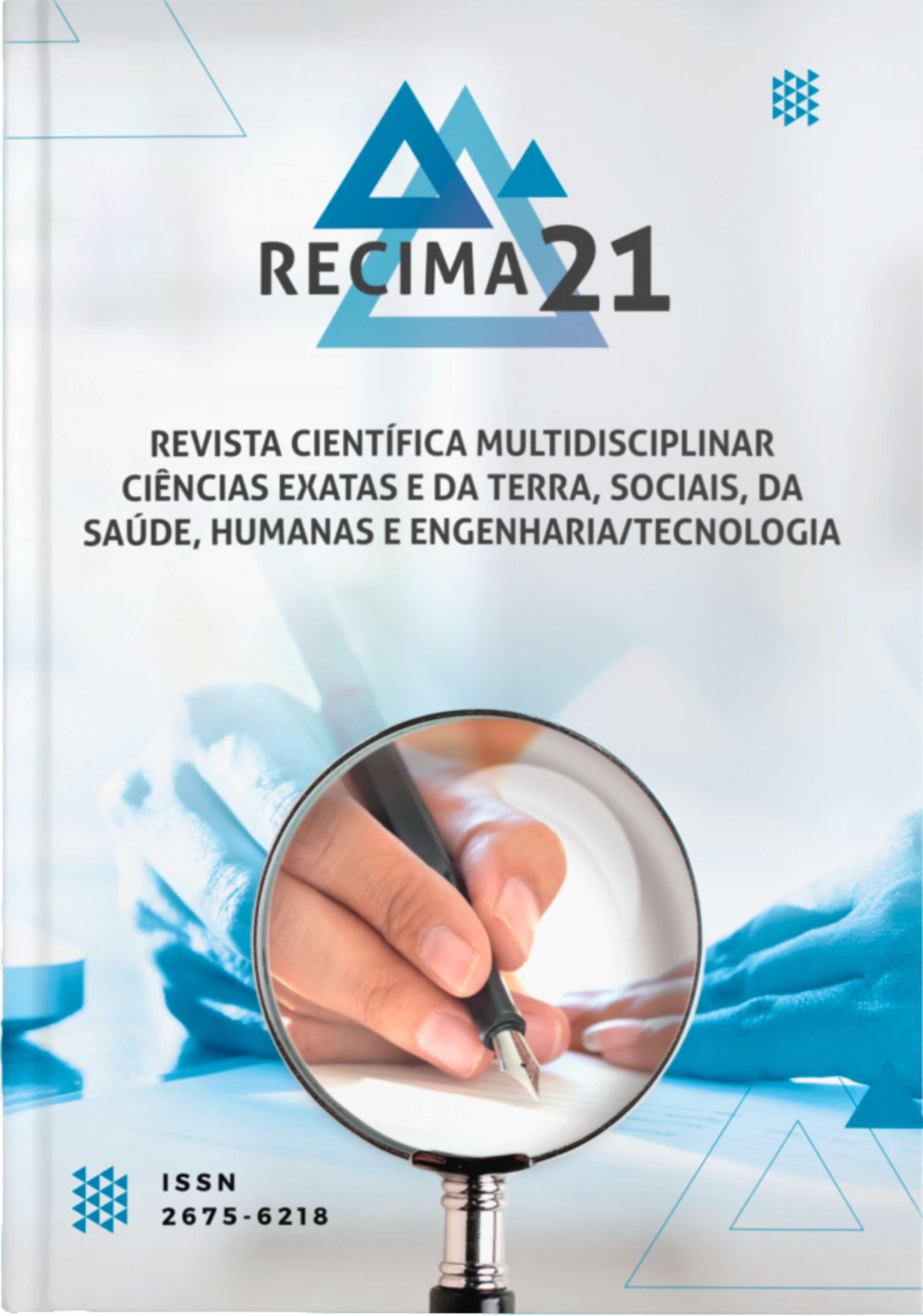SMOKING: A CHALLENGE TO BE DONE
DOI:
https://doi.org/10.47820/recima21.v2i10.805Keywords:
Tobacco, Nicotine, Tar, ToxicologyAbstract
Objective: elucidate the toxicological effects of tobacco derivatives on the human body, the difficulties and justifications in quitting smoking, the impact on society, including the financial parts of health and quality of life. Methodology: The document was built after a theoretical review of tobacco and its toxic effects on humans. The bibliographic survey was carried out using the PubMed, Lilacs, Scielo and Google Scholar Databases Result: tobacco is a mixture of approximately 4,700 toxic substances that are distributed in two phases of compounds of high degree of toxicity; we address nicotine and its high capacity to generate dependence; we seek to inform the difficulty that an individual has in abolishing the habit, by which nicotine produces effects that reinforce its use. The severity of nicotine dependence can be illustrated with the fact that only 33% of people who quit smoking alone remain abstinent for more than 2 days, and less than 5% remain abstinent for more than 1 year. Conclusion: advances in tobacco control depend on a vision of the future based on goals, strategies and rigidity in anti-smoking policies
Downloads
References
Muakad IB. Tabagismo: maior causa evitável de morte do mundo. Rev. Fac. Direito Univ. São Paulo [Internet]. 6 de dezembro de 2014; doi: 1090:527-58. Disponível em: https://www.revistas.usp.br/rfdusp/article/view/89244.
Oga S, Camargo MM de A, Batistuzzo JA de O. Fundamentos de toxicologia. 2021.
Costa e Silva, VL and Koifman, S. Smoking in Latin America: a major public health problem. Cadernos de Saúde Pública [online]. 1998, v. 14, suppl 3 pp. S109-S115. Available from: <https://doi.org/10.1590/S0102-311X1998000700010>.
Salem Szklo A, Lacerda Mendes F, Cavalcante TM, Viegas JR. Interferência da Indústria do Tabaco no Brasil: a Necessidade do Ajuste de Contas. Rev. Bras. Cancerol. [Internet]. 2020; 66(2). Disponível em: https://rbc.inca.gov.br/revista/index.php/revista/article/view/878.
Hoffmann D, Hoffmann I, El-Bayoumy K. The less harmful cigarette: a controversial issue. a tribute to Ernst L. Wynder. Chem Res Toxicol. 2001 Jul;14(7):767-90. doi: 10.1021/tx000260u.
Paumgartten FJR, Gomes-Carneiro MR, Oliveira ACAX. The impact of tobacco additives on cigarette smoke toxicity: a critical appraisal of tobacco industry studies. Cad Saude Publica. 2017 Sep 21;33Suppl 3. doi: 10.1590/0102-311X00132415
Alkam T, Nabeshima T. Molecular mechanisms for nicotine intoxication. Neurochem Int. 2019 maio: 125:117-126. doi: 10.1016/j.neuint.2019.02.006..
Marques, Ana Cecilia P R. Consenso sobre o tratamento da dependência de nicotina. Brazilian J Psychiatry. 2001;23(4):200-14. Disponível em: <https://doi.org/10.1590/S1516-44462001000400007>.
Chatkin, JM. A influência da genética na dependência tabágica e o papel da farmacogenética no tratamento do tabagismo. Jornal Brasileiro de Pneumologia [online]. 2006, v. 32, n. 6, pp. 573-579. https://doi.org/10.1590/S1806-37132006000600016.
Inácio, D. A. S., and B. A. Brandão.”Toxicologia Forense: Intoxicação por Monóxido de Carbono em Carbonizados“. Brazilian Journal of Forensic Sciences, Medical Law and Bioethics 5 (3) (2016): 314–27. Doi: http://dx.doi.org/10.17063/bjfs5(3)y2016314.
Hecht SS. Chemoprevention of cancer by isothiocyanates, modifiers of carcinogen metabolism. J Nutr. 1999 Mar;129(3):768S-774S. doi: 10.1093/jn/129.3.768S.
Meire RO, et al. Aspectos ecotoxicológicos de hidrocarbonetos policíclicos aromáticos. Oecologia Brasiliensis, Vol. 11, Nº. 2, 2007, pags. 188-201, doi: 10.4257.
Peres AC, Hiromoto G. Evaluation of 210Pb and 210Po in cigarette tobacco produced in Brazil. J Environ Radioact. 2002;62(1):115-9. doi: 10.1016/s0265-931x(01)00146-1.
Harrison J, Leggett R, Lloyd D, Phipps A, Scott B. Polonium-210 as a poison. J Radiol Prot. 2007 Mar;27(1):17-40. doi: 10.1088/0952-4746/27/1/001.
Nuncio D, Trindade FR. Presença de Polônio-210 no tabaco: uma revisão sistemática. Destaques Acadêmicos. 2016 Apr 20;8(3):189-203. DOI: http://dx.doi.org/10.22410/issn.2176-3070.v8i3a2016.1150
Primo, CC. Effects of maternal nicotine on breastfeeding infants. Revista Paulista de Pediatria [online]. 2013, v. 31, n. pp. 392-397. Disponível em: <https://doi.org/10.1590/S0103-05822013000300018>.
Instituto Nacional de Câncer (org). Tabagismo passivo: a importância de ambientes 100% livres da fumaça de tabaco. Comissão Nacional Para Implementação da Convenção-Quadro da Organização Mundial da Saúde Para O Controle do Tabaco (Conicq); 2017; Rio de Janeiro.; 2017. 57 p.
Instituto Nacional do Câncer (org.). Uso de narguilé: efeitos sobre a saúde, necessidades de pesquisa e ações recomendadas para legisladores. 2. ed. Rio de Janeiro, Rj: Coordenação de Ensino Serviço de Educação e Informação Técnico-Científica, 2017. 49 p.
Silva, A. L. O.; Moreira, J. C.; Martins, S. R. COVID-19 and smoking: a high-risk association. Cad. Saúde Pública. 2020;36(5). doi: https://doi.org/10.1590/0102-311x00072020.
Garcia LPRR. A COVID-19 e o tabagismo: uma relação a ser estabelecida. Boletim Epidemiológico [internet]. 2021 Jan 12;22(1):1-8. Acesso em: https://www.saude.go.gov.br/files//boletins/epidemiologicos/diversos/2021/A%20COVID-19%20e%20o%20tabagismo%20uma%20rela%C3%A7%C3%A3o%20a%20ser%20estabelecida.pdf
Downloads
Published
How to Cite
Issue
Section
Categories
License
Copyright (c) 2021 RECIMA21 - Revista Científica Multidisciplinar - ISSN 2675-6218

This work is licensed under a Creative Commons Attribution 4.0 International License.
Os direitos autorais dos artigos/resenhas/TCCs publicados pertecem à revista RECIMA21, e seguem o padrão Creative Commons (CC BY 4.0), permitindo a cópia ou reprodução, desde que cite a fonte e respeite os direitos dos autores e contenham menção aos mesmos nos créditos. Toda e qualquer obra publicada na revista, seu conteúdo é de responsabilidade dos autores, cabendo a RECIMA21 apenas ser o veículo de divulgação, seguindo os padrões nacionais e internacionais de publicação.













